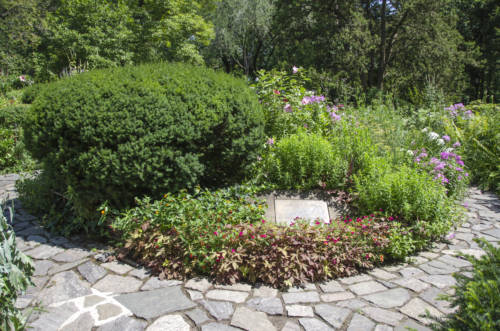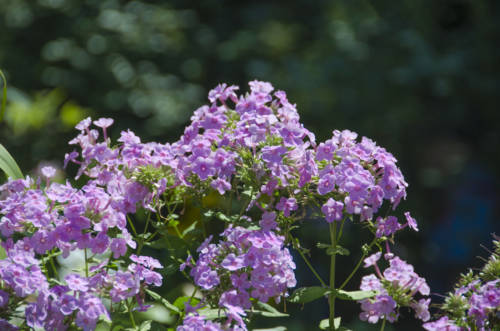
Inside the Central Park Shakespeare Garden
“I know a bank where the wild thyme blows,
Where oxlips and the nodding violet grows;
Quite over-canopied with luscious woodbine,
With sweet musk-roses and with eglantine:
There sleeps Titania sometime of the night,
Lull’d in these flowers with dances and delight.”
Oberon in Midsummer Night’s Dream act ii sc.I
A short walk from the well-known Delacorte Theater that houses the New York Shakespeare Festival in Central Park, is a romantic, rustic, 4-acre garden designed in honor of William Shakespeare. The Shakespeare Garden is one of the most famous in the world and features plants and pathways typically found in his English country garden at Stratford-on-Avon.
Dedicated 100 years ago in 1916 (on the 300th anniversary of Shakespeare’s death), the Shakespeare Garden was maintained for many years by members of the Shakespeare Society along with Dr. Edmond Bronk Southwick, who was both a Parks Department entomologist and a Shakespeare fan. Dr. Southwick first developed the area by planting bulbs and seeds in 1913. He called it the “Garden of the Heart.”
But even before his time, as early as the 1880’s, a cutting from an ancient mulberry tree said to be from Shakespeare’s own Stratford garden was planted in the garden at Central Park. The resulting mulberry tree lived more than 120 years until 2006, when it was taken down by a summer storm and had to be removed.
Fully Restored in 1987
The garden was fully restored by the Central Park Conservancy in 1987. Landscape designers Bruce Kelly and David Varnell, hired by the Conservancy, expanded the area — repaving paths, adding lovely bronze plaques with Shakespeare quotations, and installing rustic fences and wooden benches (recently replaced by the Conservancy with newer versions).
According to the Conservancy’s Senior Zone Gardener, Larry Boes, the basic footprint of the garden has remained the same since the 1987 restoration. When Boes became the gardener in 2008, he moved several of the Shakespeare plaques to locations where he could actually grow the plants mentioned.
Some of the plants you see in mid-summer include lots of lilies, globe thistle (Echinops ritro), giant hyssop (Agastache), shasta daisy (Leucanthemum), roses, cone flowers (Echinacea), trumpet vine (Campsis radicans), meadow rue (Thalictrum), bee balm (Monarda), cup plant (Silphium perfoliatum), prairie dock (Silphium terebinthinaceum), and many annuals.
Special Plantings
“There’s rosemary, that’s for remembrance; pray,
love, remember: and there is pansies, that’s for thoughts.”
Ophelia in Hamlet act iv sc.V
There are more than 200 varieties of plants in the Shakespeare garden and some are very special. In the spring, the display of “minor bulbs” is probably “the most comprehensive in the park,” says Boes.
In honor of the garden’s centennial year Boes added some more plants once found in Shakespeare’s Stratford-on-Avon garden, including strawberry blite (Chenopodium capitatum), runner beans (Phaseolus coccineus), and peas (Pisum sativum).
He notes, “The fringe tree (Chionanthus virginicus) is one that many regular visitors wait all year to see with its showy white flowers and amazing fragrance.”
Another standout is the purple spring bulb known in Shakespeare’s time as a guinea hen (Fritillaria meleagris) — its white-checkered petals resemble the hen’s feathers.
Love Story Spot
Its lush foliage and enclosed setting make the Shakespeare Garden a perfect place for a small wedding ceremony and there have been many of them. While there are some unique rules and regulations for weddings in the park– among them, no throwing rice, flower petals, or confetti — the good news is that the space remains one of several more relaxing “quiet zones,” in the park.
The pathways are perfect for taking pictures. A big bonus: your pets are permitted in the wedding party, on a leash.
Beyond Romance: A Healing Garden
Shakespeare, like many Elizabethans, was immersed in the folklore and symbolism surrounding plants. He often referred to the medicinal qualities of plants in his sonnets and plays.
Recently, researchers at the Folger Shakespeare Library in Washington D.C. identified several key plants that Shakespeare would have known well and that Elizabethans valued not only for their romance and beauty, but for their healing properties. If you’re thinking of creating your own Shakespeare garden, the Folger plant list might be a good starting point. It includes:
- Dianthus or pinks—if mulled in hot wine this plant was thought to prevent the plague.
- Holly – making a tea from holly leaves could help treat a fever.
- Ivy – an ivy leaf “bruised in wine” was used to cure hangovers and if ivy leaves were placed under a girl’s pillow, sweet dreams of future lovers could magically appear.
- Lavender – housewives used it for cleaning and bathing; they also dried wet clothes on lavender bushes so they would be scented with a natural moth repellant.
- Linden – the trees attract bees and Elizabethans prized both honey and beeswax.
- Rose – “Christmas roses” were used to treat madness and melancholy.
- Rosemary – used to cure tooth decay, nightmares, and other ills.
- Saffron Crocus – often used as a dye but also “the viagra of its day.”
- Thyme – an herbal remedy for many different ills including coughs.






































